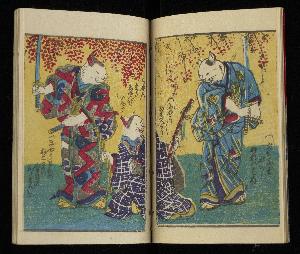Utagawa Kunimasa
歌川 国政;Utagawa Kunimasa
Place: Aizu
Born: 1773
Death: 1810
Biography:
Early Life and Training
Kunimasa originated from Aizu in Iwashiro Province and initially worked in a dye shop after arriving in Edo (modern Tokyo). It was there that he caught the attention of Utagawa Toyokuni, to whom he became apprenticed. This mentorship played a significant role in shaping Kunimasa's artistic style, which was characterized by its unique blend of intensity and decorative pageantry. Artistic Style and Techniques
Kunimasa's style has been described as an attempt to combine the intensity of Sharaku with the decorative pageantry of his master Utagawa Toyokuni. Although some critics argue that he failed to achieve the level of Sharaku's intensity, Kunimasa's works remain highly regarded for their beauty and elegance. His use of color and composition was particularly notable, as seen in his yakusha-e portrait prints and bijin-ga pictures. Notable Works
Some of Kunimasa's most notable works include his portraits of kabuki actors and his bijin-ga pictures of beautiful women. These works showcase his ability to capture the essence of his subjects, conveying a sense of drama and emotion. His use of color and composition was also highly effective in creating a sense of tension and drama. Legacy
Kunimasa's legacy can be seen in the many artists who followed in his footsteps. His unique style and technique have influenced generations of ukiyo-e artists, and his works continue to be celebrated for their beauty and elegance. The Utagawa Kunimasa is a testament to the enduring power of ukiyo-e art, and his legacy continues to inspire artists and art lovers alike. Important to note that Kunimasa's works can be found in various museums and collections, including the Museum of Fine Arts, Boston, and the Metropolitan Museum of Art. His paintings are also available for viewing on Wikioo.org, where you can find a wide range of his works, including Utagawa Kunimasa's biography and paintings.
Key aspects of Kunimasa's life and work can be found in the Utagawa school, where he was trained by Utagawa Toyokuni. His unique style and technique have made him a prominent figure in the ukiyo-e art movement, and his legacy continues to inspire artists and art lovers alike.

![Neko no shibai 猫の芝居 [Cat theatre] Neko no shibai 猫の芝居 [Cat theatre]](https://img.wikioo.org/ADC/art.nsf/get_small_image_wikioo?Open&ra=DD28NT)


